Fuzzy Inference Model for Decision Support in Sustainable Production Planning Processes—A Case Study
Abstract
:1. Introduction
2. Theoretical Background and Methods
2.1. Production Planning from a Sustainable Development Perspective
2.2. Fundamentals for Sustainability Evaluation of Enterprise Systems Using Fuzzy Logic
- The fuzzification step fuzzifies selected variables (x) into fuzzy values (µx) in an interval between zero and one using membership functions.
- The aggregation step aggregates the fuzzy values to a single membership value using single or multiple fuzzy operators.
- The defuzzification step converts the aggregated membership value into a crisp value determining the fuzzy model’s output.
| Reference | Goal of the Model | Target System | Input Variables (Membership Function) | Aggregation | Defuzzification |
|---|---|---|---|---|---|
| [36] | Ranking of relevant sustainability issues for strategic decision-making | Enterprise |
|
| Centroid defuzzification |
| [35] | Corporate sustainability evaluation of an enterprise | Enterprise |
|
| Centroid defuzzification |
| [40] | Ranking of GRI indicators for sustainability reporting | Enterprise |
|
| |
| [37] | Social performance of an enterprise | Enterprise |
|
| Average score |
| [41] | Corporate sustainability evaluation of an enterprise | Enterprise |
|
| Height method |
| [13] | Sustainable evaluation of a chemical plant | Enterprise |
|
| Score |
| [31] | Sustainability evaluation of renewable energy plants | Production |
|
| Singleton defuzzification |
| [33] | Sustainable electrical power generation | Production |
|
| Centroid defuzzification |
| [42] | Production planning of an assembly line | Production |
|
| Genetic algorithm to maximize aggregated value |
| [34] | Ranking of pavement options | Products |
|
| |
| [32] | Sustainable product design | Product |
|
| Weighted score |
3. General Scope of the Fuzzy Inference Model Evaluating Production Programs According to Sustainability Aspects
- The production process converts production inputs (raw materials, energy, workforce, and information) into production outputs (products, by-products, emissions) with the required quality, safety, and timeliness.
- The inventory process coordinates, directs, controls, and tracks inventory and resources (material and energy) movements within the production system.
- The maintenance process maintains the equipment and tools to secure their availability for production processes and to ensure scheduling for periodic or preventive maintenance.
- The quality process coordinates, directs, and tracks the processes that test materials and equipment to measure and verify quality measures.
- The on-site generation of energy process provides energy to the production process. The energy can be generated by, e.g., renewable energy plants, heating boilers, and energy recovery systems.
- The water and material reuse process returns effluent and used materials in the production process, so long as the effluent and used materials still have an acceptable quality level.
- The product refurbishment process returns products from the customer in the production system. The product is repaired, cleaned, and sold as a second-hand product to customers.
- The product remanufacturing process returns products from the customer in the production system, too. The product is dismantled, repaired, cleaned, and sold as a new product to customers.
4. General Procedure and Mathematical Formulation of the Fuzzy Inference Model
- 1.
- Selection of suitable variables for sustainable production planning,
- 4.
- Definition of membership function for the fuzzification process,
- 5.
- Selection of a rules engine and suitable fuzzy operator,
- 6.
- Definition of a function for the defuzzification process, and
- 7.
- Decision-making procedure for sustainable production planning.
4.1. Selection of Suitable Variables for Sustainable Production Planning
- State of Sustainability (µS) considering economic, social, and environmental aspects of the production system, and
- Flexibility (µF) to implement a defined change of state in a production system through, e.g., shifting the start of production activities, interrupting production activities, using alternative resources for activities, adjusting the process parameter.
- Publication date must be between 2000 and 2020.
- Publication must be available in the usual databases (e.g., Science Direct, Scopus).
- The study must consider at least one sustainability aspect of machine scheduling for the manufacturing industry sector. Studies that consider only conventional production planning goals (e.g., reduction of makespan) are not considered.
- Approaches considering product- or machine-related planning problems (e.g., cutting-stock, single machine energy efficiency) are not considered.
- The variable must be relevant regarding sustainable manufacturing for the considered production system and set system boundaries (model scope).
- The variable for sustainability must be improvable through actions for production planning (e.g., shifting or interrupting of production activities, change of resource types), which is determined by variables for flexibility.
- The variables must be independent of each other. Double counting of benefits or impacts (e.g., decrease in energy consumption, decrease in energy costs, as well as GHG emissions) must be avoided.
- Data must be available and accessible for the selected variables considering production inputs and outputs.
4.2. Fuzzification of the Variables
- The subjective approach relies on the collection of experience and knowledge from experts in the area of study, where experimental data are incomplete and imprecise (e.g., determination of warm and cold room temperatures).
- The data-driven approach clusters experimental data into subregions that can be linguistically interpreted as, e.g., low and high. Common data-driven methods are data clustering, machine learning, benchmarks, statistical analyses, mathematical models, and simulations.
- For variables that aim to minimize or constrain sustainability impacts (e.g., GHG emissions, production costs), the linear membership function seems most appropriate. For this membership function, the upper limit x1 and lower limit x2 need to be defined for the selected variables. The range between x1 and x2 presents the potential to minimize or constrain sustainability impacts.
- For variables that aim to balance a variable at a specific value (e.g., peak power), the triangle membership function seems most appropriate. For this membership function, the upper limit x2 and lower limits x1 and x3 need to be defined for the selected variables. The range between x1 and x3 presents the potential to minimize or constrain sustainability impacts.
- For variables that aim to balance a variable at a specific range (e.g., recovery time), the trapezoidal membership function seems most appropriate. For this membership function, the upper limits x2 and x3 and lower limits x1 and x4 need to be defined for the selected variables. The range between x1 and x2, and x3 and x4 presents the potential to minimize or constrain sustainability impacts.
4.3. Aggregation of the Fuzzy Values
- For the individual rule inference engine, the rules are defined individually for a single variable and defined fuzzy sets (e.g., low, medium, high). The number of rules rises exponentially with the number of selected variables and defined fuzzy sets.
- For the composition rule inference engine, the fuzzy set rules are aggregated in one fuzzy membership function for a single variable. Therefore, the number of rules is equal to the number of variables.
- The single sustainability potential is determined by combining the variable for the state of sustainability and flexibility.
- The fuzzy values for multiple sustainability potentials are combined to determine the overall sustainability potential to improve the production program.
- IF [State of Sustainability] is High THEN [Potential] is Low (µP → 0).
- IF [State of Sustainability] is Low AND [Flexibility] is High THEN [Potential] is High (µP → 1).
- IF [State of Sustainability] is Low AND [Flexibility] is Low THEN Potential Medium (µP → 0.5).
- 4.1.
- IF [State of Sustainability] is Low AND [Flexibility] is Medium THEN [Potential] is High-Medium.
- 4.2.
- IF [State of Sustainability] is Medium AND [Flexibility] is High THEN [Potential] is Medium-Low.
- 4.3.
- IF [State of Sustainability] is Medium AND [Flexibility] is Medium THEN [Potential] is Medium.
- 4.4.
- IF [State of Sustainability] is Medium AND [Flexibility] is Low THEN [Potential] is Medium-Low.
4.4. Defuzzification of the Aggregated Fuzzy Values
- Low potential state indicates a high state of sustainability.
- ◦
- Therefore, no more action is required to change the production program.
- ◦
- The range should be as close as required to zero because higher values decrease the planning effort to reach a low sustainability state.
- High potential state indicates a low or medium state of sustainability and high production flexibility.
- ◦
- Therefore, the production program can be adjusted to improve the sustainability.
- ◦
- According to the expected model outcome, the range should be started between 0.55 and 0.75 (see Figure 5).
- Medium potential state indicates a low or medium state of sustainability and low production flexibility.
- ◦
- The production must be adjusted to increase the flexibility.
- ◦
- The range is between low and high potential to improve the production program.
4.5. Decision-Making Procedure for Sustainable Production Planning
- The production goal is controlled:
- ◦
- If the production goal is not achieved (f = 0), the production goal variable needs to be adjusted, and the sustainability assessment is repeated.
- ◦
- If the production goal is achieved, no action is required.
- The sustainability potentials are controlled:
- ◦
- If the sustainability potential is medium or high, the sustainability goal variable needs to be adjusted. For this approach, the sustainability variables are ranked according to their sustainability potential identifying the highest sustainability potential. The related variables need to be further controlled:
- ▪
- If the flexibility variable is low (µF = Low), the flexibility variable needs to be adjusted, and the sustainability assessment is repeated.
- ▪
- If the flexibility variable is medium or high (µF = Low, µF = Medium), the sustainability variable needs to be adjusted, and the sustainability assessment is repeated.
- ◦
- If all production goals are achieved, and the sustainability potential is low, no action is required, and the decision process is finished.
- Shift specific production activities.
- Interrupt production activities.
- Turn machines off or on.
- Increase the capacity of machines/human workforce.
- Use machines with lower resource demand.
- Use resources with lower sustainability impact.
- Exchange employees for specific production activities.
5. Single Case Analysis of the Fuzzy Inference Model
- Definition of the single case studies scope,
- Collection of required data for test scenarios (inventory analysis), and
- Presentation of test scenario results.
5.1. Scope Definition of the Case Study
- If the renewable energy generation is higher than the energy demand, renewable energy can be sold to other companies.
- If the renewable energy generation is lower than the energy demand, conventional energy is purchased by an external energy supplier, which causes higher energy costs and indirect GHG emissions. Therefore, the demand for renewable energy should always be preferred in the production process.
- Reused carriers can be purchased from other companies, which causes higher material costs only.
- If reused carriers from other companies are not available, new carriers are purchased from an external supplier, which causes higher material costs and impacts natural resources. Therefore, internal or external reused carriers should always be preferred for material preparation.
5.2. Definition of the Fuzzy Sets for the Case Study
- Only White Product
- Only Red Product
- Only Blue Product
- Equal Product Mix (White/Red/Blue)
5.3. Presentation and Discussion of Test Scenario Results
- Low utilization (29%, 10 products/hour) of the production system producing a product mix.
- High utilization (94%, 32 products/hour) of the production system producing a product mix.
- One production hour is simulated.
- The following production goals are set:
- ◦
- Low utilization production scenario: 10 products/hour
- ◦
- High utilization production scenario: 30 products/hour
- The net performance of the renewable energy generation is 15 kW.
- An external company provides ten external reused carriers for material preparation.
- The accumulated work stress starts at zero.
- The presented function Figure 6 is used for the defuzzification process.
- One iteration step is performed according to the decision-making procedure.
6. Conclusions and Outlook
Author Contributions
Funding
Institutional Review Board Statement
Informed Consent Statement
Data Availability Statement
Conflicts of Interest
Appendix A
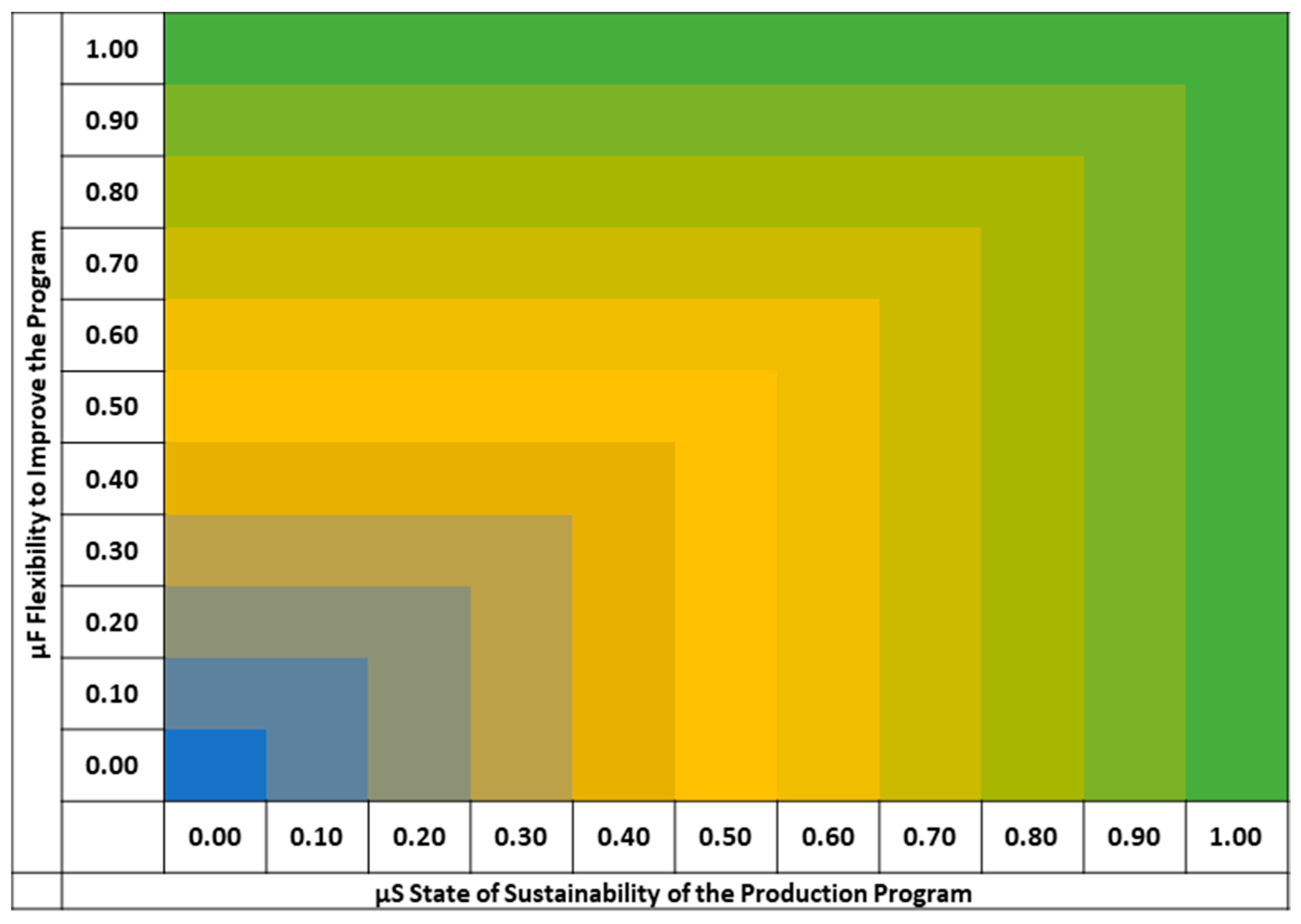
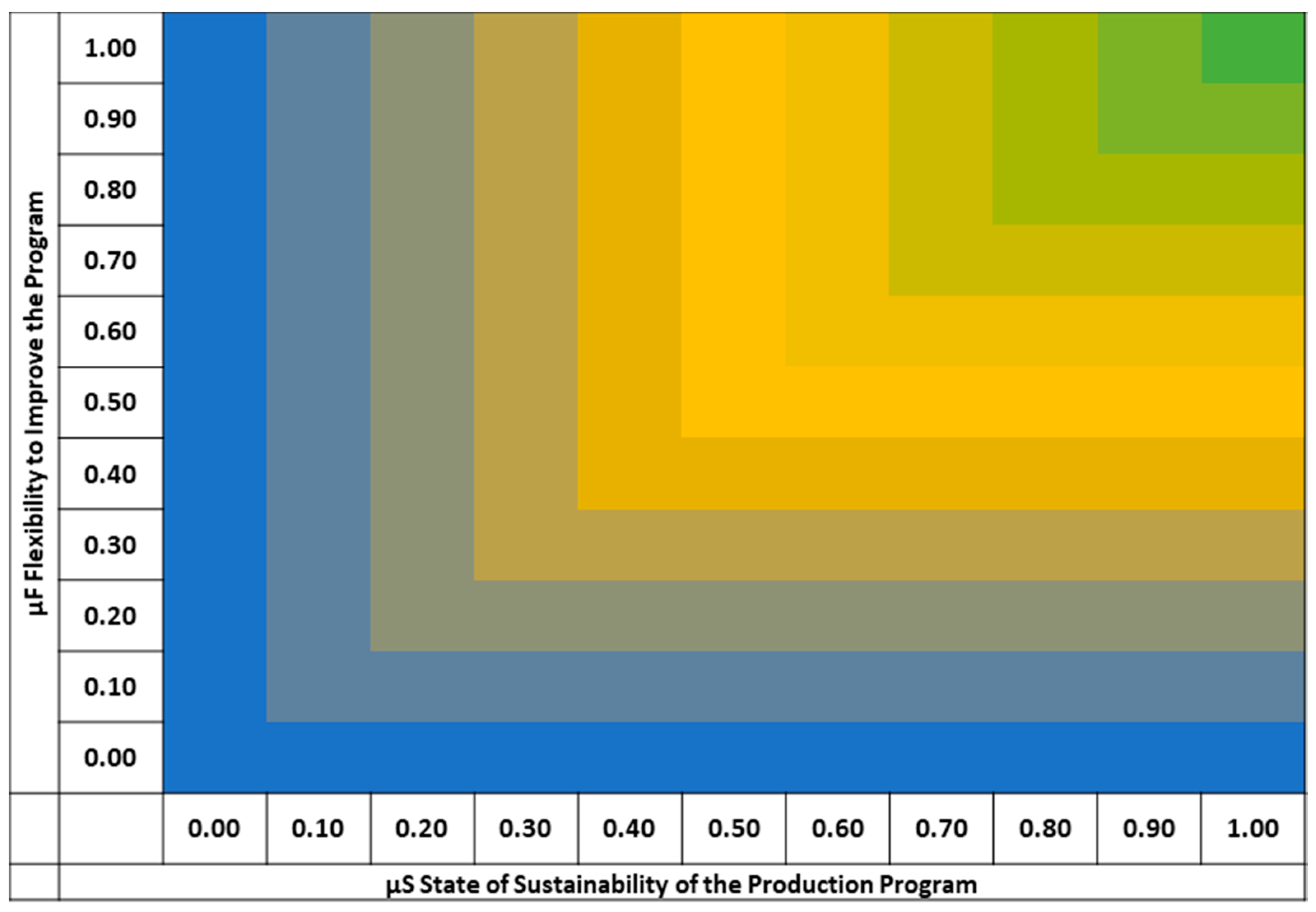
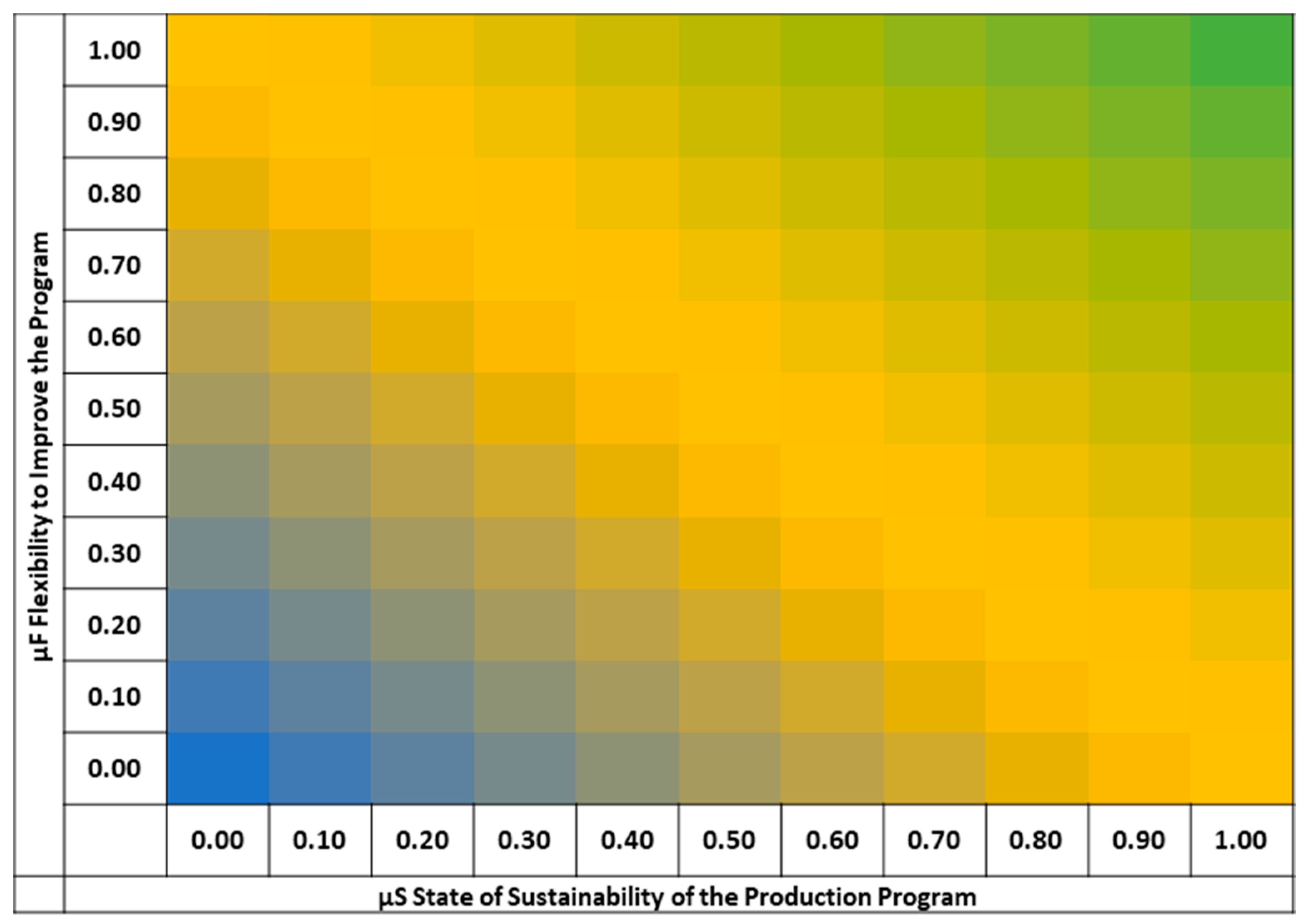
Appendix B
| Only Product White | Only Product Red | Only Product Blue | Product Mix | |
|---|---|---|---|---|
| Product Ratio (White/Red/Blue) | 1/0/0 | 0/1/0 | 0/0/1 | 1/1/1 |
| Max. Product Output | 31 Products/hour | 38 Products/hour | 31 Products/hour | 33 Products/hour |
| Minimal Lead Time | 242.6 s | 214.4 s | 243.9 | |
| Energy Demand | 0.62 kWh/Product | 0.44 kWh/Product | 0.53 kWh/Product | 0.55 kWh/Product |
| Power Peak at Max. Production Output | 45 kW | 29 kW | 37.5 kW | 37 kW |
| Workload Material Preparation | 10.94 kJ/Product | 10.94 kJ/Product | 10.94 kJ/Product | 10.94 kJ/Product |
| Workload Peak at Max. Production Output in 1 Working Hour. | 413.34 kJ | 496.81 kJ | 407.83 kJ | 419.66 kJ |
Appendix C
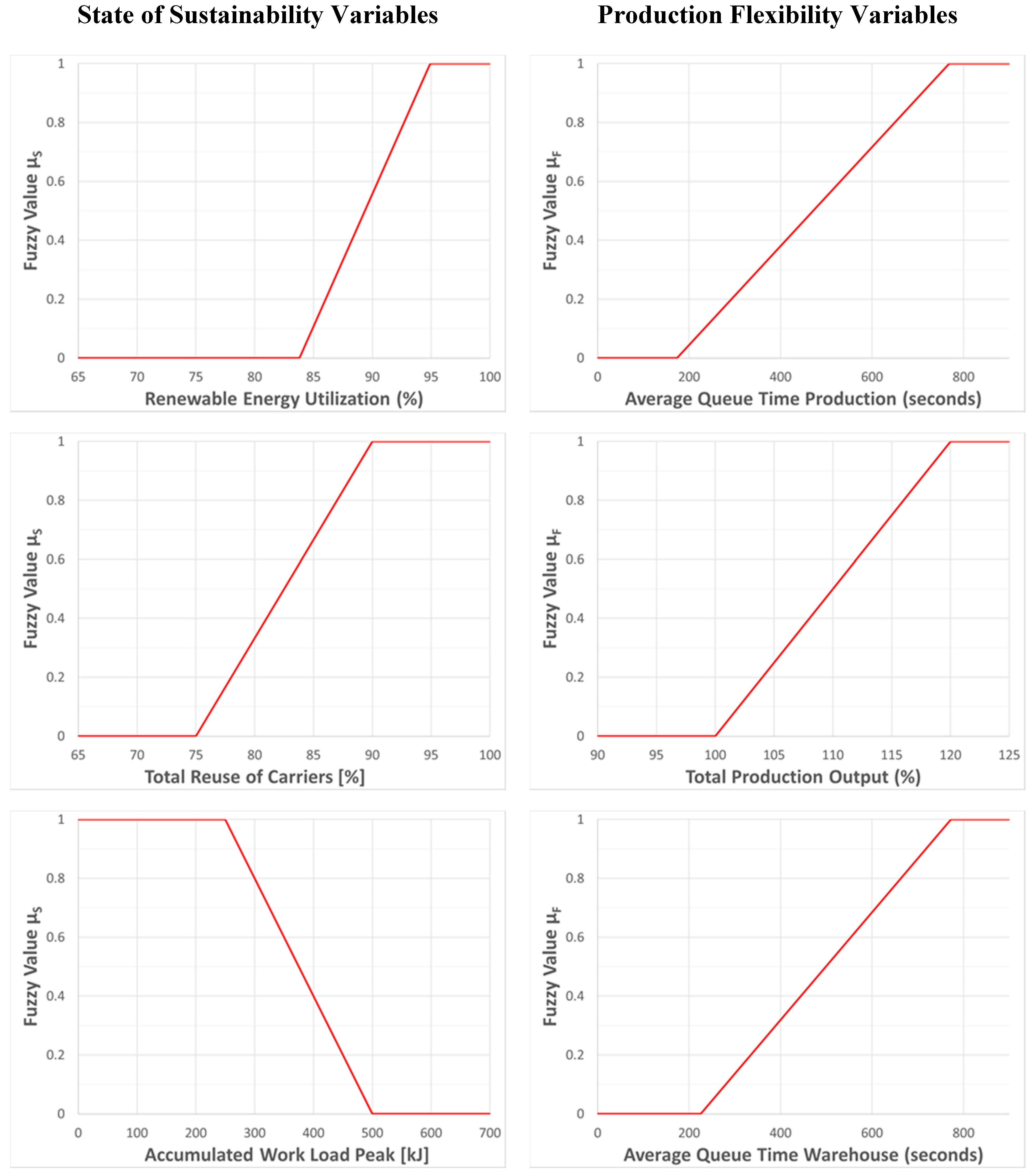
Appendix D

References
- Bundesministerium für Wirtschaft und Energie. Fakten zum Deutschen Außenhandel. Available online: https://www.bmwi.de/Redaktion/DE/Publikationen/Aussenwirtschaft/fakten-zum-deuschen-aussenhandel.html (accessed on 27 January 2021).
- Bundesministerium für Umwelt, Naturschutz und Nukleare Sicherheit. Umweltbericht der Bundesregierung 2019: Umwelt und Natur als Fundament des sozialen Zusammenhaltes. Available online: https://www.bmu.de/download/umweltberichte/ (accessed on 14 October 2020).
- Meadows, D.H.; Randers, J.; Meadows, D.L. Limits to Growth. The 30-Year Update; Chelsea Green Publishing Company: White River Junction, VT, USA, 2004; ISBN 9781931498586. [Google Scholar]
- Brundtland Commission. World Commission on Environment and Development. Our Common Future; Oxford Paperbacks; Oxford University Press: Oxford, UK, 1987. [Google Scholar]
- United Nations. Sustainable Development Goals. Available online: https://sdgs.un.org/goals (accessed on 26 October 2020).
- Neves, A.; Godina, R.; Azevedo, S.G.; Matias, J.C.O. A comprehensive review of industrial symbiosis. J. Clean. Prod. 2020, 247, 119113. [Google Scholar] [CrossRef]
- Suzanne, E.; Absi, N.; Borodin, V. Towards circular economy in production planning: Challenges and opportunities. Eur. J. Oper. Res. 2020. [Google Scholar] [CrossRef]
- Giret, A.; Trentesaux, D.; Prabhu, V. Sustainability in manufacturing operations scheduling: A state of the art review. J. Manuf. Syst. 2015, 37, 126–140. [Google Scholar] [CrossRef]
- Sutherland, J.W.; Richter, J.S.; Hutchins, M.J.; Dornfeld, D.; Dzombak, R.; Mangold, J.; Robinson, S.; Hauschild, M.Z.; Bonou, A.; Schönsleben, P.; et al. The role of manufacturing in affecting the social dimension of sustainability. CIRP Ann. 2016, 65, 689–712. [Google Scholar] [CrossRef] [Green Version]
- Akbar, M.; Irohara, T. Scheduling for sustainable manufacturing: A review. J. Clean. Prod. 2018, 205, 866–883. [Google Scholar] [CrossRef]
- Trost, M.; Forstner, R.; Claus, T.; Herrmann, F.; Frank, I.; Terbrack, H. Sustainable Production Planning and Control: A systematic Literature Review. In Proceedings of the European Conference on Modelling and Simulation, Caserta, Italy, 11–14 June 2019; Volume 33. [Google Scholar]
- Al-Sharrah, G.; Elkamel, A.; Almanssoor, A. Sustainability indicators for decision-making and optimisation in the process industry: The case of the petrochemical industry. Chem. Eng. Sci. 2010, 65, 1452–1461. [Google Scholar] [CrossRef]
- Piluso, C.; Huang, J.; Liu, Z.; Huang, Y. Sustainability Assessment of Industrial Systems under Uncertainty: A Fuzzy Logic Based Approach to Short-Term to Midterm Predictions. Ind. Eng. Chem. Res. 2010, 49, 8633–8643. [Google Scholar] [CrossRef]
- Phillis, Y.A.; Kouikoglou, V.S. Fuzzy Measurement of Sustainability; Nova Science Publishers: New York, NY, USA, 2009; ISBN 978-1-60741-900-6. [Google Scholar]
- Zadeh, L.A. Fuzzy sets. Inf. Control 1965, 8, 338–353. [Google Scholar] [CrossRef] [Green Version]
- Taticchi, P.; Garengo, P.; Nudurupati, S.S.; Tonelli, F.; Pasqualino, R. A review of decision-support tools and performance measurement and sustainable supply chain management. Int. J. Prod. Res. 2015, 53, 6473–6494. [Google Scholar] [CrossRef]
- Biel, K.; Glock, C.H. Systematic literature review of decision support models for energy-efficient production planning. Comput. Ind. Eng. 2016, 101, 243–259. [Google Scholar] [CrossRef]
- Diaz-Balteiro, L.; González-Pachón, J.; Romero, C. Measuring systems sustainability with multi-criteria methods: A critical review. Eur. J. Oper. Res. 2017, 258, 607–616. [Google Scholar] [CrossRef]
- Zarte, M.; Wermann, J.; Heeren, P.; Pechmann, A. Concept, Challenges, and Learning Benefits Developing an Industry 4.0 Learning Factory with Student Projects. In Proceedings of the IEEE 17th International Conference on Industrial Informatics (INDIN), Helsinki, Finland, 22–25 July 2019; pp. 1133–1138. [Google Scholar] [CrossRef]
- Zarte, M.; Pechmann, A.; Nunes, I.L. Decision support systems for sustainable manufacturing surrounding the product and production life cycle—A literature review. J. Clean. Prod. 2019, 219, 336–349. [Google Scholar] [CrossRef]
- Daly, H.E. Toward some operational principles of sustainable development. Ecol. Econ. 1990, 2, 1–6. [Google Scholar] [CrossRef]
- Deutsche Kommission Elektrotechnik Elektronik Informationstechnik. Enterprise-Control System Integration—Part 1: Models and Terminology; CEN: Frankfurt, Germany, 2013. [Google Scholar]
- Graves, S.C. Manufacturing Planning and Control; Massachusetts Institute of Technology: Cambridge, MA, USA, 1999. [Google Scholar]
- World Business Council for Sustainable Development. Sustainable Consumption Facts and Trends: The Business Role Focus Area. Available online: https://www.wbcsd.org/Programs/People/Sustainable-Lifestyles/Resources/Sustainable-consumption-facts-trends (accessed on 2 December 2020).
- Elkington, J. Partnerships fromcannibals with forks: The triple bottom line of 21st-century business. Environ. Qual. Manag. 1998, 8, 37–51. [Google Scholar] [CrossRef]
- Moldavska, A.; Welo, T. The concept of sustainable manufacturing and its definitions: A content-analysis based literature review. J. Clean. Prod. 2017, 166, 744–755. [Google Scholar] [CrossRef]
- U.S. Environmental Protection Agency. Sustainable Manufacturing. Available online: https://www.epa.gov/sustainability/sustainable-manufacturing (accessed on 14 February 2020).
- Bungartz, H.-J.; Buchholz, M.; Pflüger, D.; Zimmer, S. Modellbildung und Simulation. Eine Anwendungsorientierte Einführung; Springer: Berlin/Heidelberg, Germany, 2009; ISBN 978-3-540-79809-5. [Google Scholar]
- Cornelissen, A.M.G.; van den Berg, J.; Koops, W.J.; Grossman, M.; Udo, H.M.J. Assessment of the contribution of sustainability indicators to sustainable development: A novel approach using fuzzy set theory. Agric. Ecosyst. Environ. 2001, 86, 173–185. [Google Scholar] [CrossRef]
- Inoue, M.; Lindow, K.; Stark, R.; Tanaka, K.; Nahm, Y.-E.; Ishikawa, H. Decision-making support for sustainable product creation. Adv. Eng. Inform. 2012, 26, 782–792. [Google Scholar] [CrossRef]
- Bitter, J.; Printz, S.; Lahl, K.; Vossen, R.; Jeschke, S. Fuzzy Logic Approach for Sustainability Assessment Based on the Integrative Sustainability Triangle. In Proceedings of the 2016 World Congress on Sustainable Technologies (WCST), London, UK, 12–14 December 2016; pp. 64–69. [Google Scholar] [CrossRef]
- Ghadimi, P.; Azadnia, A.H.; Mohd Yusof, N.; Mat Saman, M.Z. A weighted fuzzy approach for product sustainability assessment: A case study in automotive industry. J. Clean. Prod. 2012, 33, 10–21. [Google Scholar] [CrossRef]
- Hemdi, A.R.; Saman, M.Z.M.; Sharif, S. Sustainability evaluation using fuzzy inference methods. Int. J. Sustain. Energy 2013, 32, 169–185. [Google Scholar] [CrossRef]
- Kucukvar, M.; Gumus, S.; Egilmez, G.; Tatari, O. Ranking the sustainability performance of pavements: An intuitionistic fuzzy decision making method. Autom. Constr. 2014, 40, 33–43. [Google Scholar] [CrossRef]
- Pislaru, M.; Herghiligiu, I.V.; Robu, I.-B. Corporate sustainable performance assessment based on fuzzy logic. J. Clean. Prod. 2019, 223, 998–1013. [Google Scholar] [CrossRef]
- Calabrese, A.; Costa, R.; Levialdi, N.; Menichini, T. Integrating sustainability into strategic decision-making: A fuzzy AHP method for the selection of relevant sustainability issues. Technol. Forecast. Soc. Chang. 2019, 139, 155–168. [Google Scholar] [CrossRef]
- Rajak, S.; Vinodh, S. Application of fuzzy logic for social sustainability performance evaluation: A case study of an Indian automotive component manufacturing organization. J. Clean. Prod. 2015, 108, 1184–1192. [Google Scholar] [CrossRef]
- Elysia, C.; Nugeraha Utama, D. Decision support model for optimal decision in strategic production planning based-on product life cycle. Int. J. Electr. Comput. Eng. 2018. [Google Scholar] [CrossRef]
- Kreimeier, D. Ressourcenorientierte Bewertung und Optimierung von Prozessketten; VDMA-Verl.: Frankfurt am Main, Germany, 2012; ISBN 3816306276. [Google Scholar]
- Calabrese, A.; Costa, R.; Levialdi, N.; Menichini, T. A fuzzy analytic hierarchy process method to support materiality assessment in sustainability reporting. J. Clean. Prod. 2016, 121, 248–264. [Google Scholar] [CrossRef]
- Kouikoglou, V.S.; Phillis, Y.A. Application of a fuzzy hierarchical model to the assessment of corporate social and environmental sustainability. Corp. Soc. Responsib. Environ. Manag. 2011, 18, 209–219. [Google Scholar] [CrossRef]
- Rajabalipour Cheshmehgaz, H.; Haron, H.; Kazemipour, F.; Desa, M.I. Accumulated risk of body postures in assembly line balancing problem and modeling through a multi-criteria fuzzy-genetic algorithm. Comput. Ind. Eng. 2012, 63, 503–512. [Google Scholar] [CrossRef]
- Normenausschuss Grundlagen des Umweltschutzes. Environmental Management—Life Cycle Assessment—Principles and Framework; CEN: Berlin, Germany, 2009. [Google Scholar]
- Le Hesran, C.; Ladier, A.-L.; Botta-Genoulaz, V.; Laforest, V. Reducing waste in manufacturing operations: A mixed integer linear program for bi-objective scheduling on a single-machine with coupled-tasks. IFAC-PapersOnLine 2018, 51, 1695–1700. [Google Scholar] [CrossRef]
- Grosse, E.H.; Calzavara, M.; Glock, C.H.; Sgarbossa, F. Incorporating human factors into decision support models for production and logistics: Current state of research. IFAC-PapersOnLine 2017, 50, 6900–6905. [Google Scholar] [CrossRef]
- Liu, Y.; Dong, H.; Lohse, N.; Petrovic, S.; Gindy, N. An investigation into minimising total energy consumption and total weighted tardiness in job shops. J. Clean. Prod. 2014, 65, 87–96. [Google Scholar] [CrossRef]
- REFA—Verband für Arbeitsstudien und Betriebsorganisation. Planung und Gestaltung komplexer Produktionssysteme; 2. Aufl; Hanser: München, Germany, 1990; ISBN 3446159673. [Google Scholar]
- Marks, P.; Yu, Q.; Weyrich, M. Survey on Flexibility and Changeability Indicators of automated Manufacturing Systems. In Proceedings of the 2018 IEEE 23rd International Conference on Emerging Technologies and Factory Automation (ETFA), Turin, Italy, 4–7 September 2018; pp. 516–523. [Google Scholar] [CrossRef]
- Chapman, S.N. The Fundamentals of Production Planning and Control; Pearson/Prentice Hall: Upper Saddle River, NJ, USA, 2006; ISBN 0-13-017615-X. [Google Scholar]
- Zarte, M.; Pechmann, A.; Nunes, I.L. Indicator framework for sustainable production planning and controlling. Int. J. Sustain. Eng. 2019, 12, 149–158. [Google Scholar] [CrossRef]
- Ross, T.J. Fuzzy Logic with Engineering Applications, 3rd ed.; John Wiley: Chichester, West Sussex, 2010; ISBN 978-0-470-74376-8. [Google Scholar]
- Saad, M.H.; Nazzal, M.A.; Darras, B.M. A general framework for sustainability assessment of manufacturing processes. Ecol. Indic. 2019, 97, 211–224. [Google Scholar] [CrossRef]
- Becker, W.-J.; Börcsök, J. (Eds.) Fuzzy Control. Theorie und Industrieeinsatz; 1. Aufl.; Verl. Technik: Berlin, Germany, 2000; ISBN 3341012373. [Google Scholar]
- Koether, R.; Kurz, B.; Seidel, U.A. Betriebsstättenplanung und Ergonomie. Planung von Arbeitssystemen; 1. Aufl.; Carl Hanser Fachbuchverlag: München, Germany, 2010; ISBN 3446210741. [Google Scholar]
- Zarte, M.; Pechmann, A.; Nunes, I.L. Design of a Platform for Sustainable Production Planning and Controlling from an User Centered Perspective. In Advances in Human Factors and Systems Interaction: Proceedings of the AHFE 2018 International Conference on Human Factors and Systems Interaction, July 21–25, 2018, Loews Sapphire Falls Resort at Universal Studios, Orlando, FL, USA; Nunes, I.L., Ed.; Springer: Cham, Switzerland, 2019; pp. 396–407. ISBN 978-3-319-94333-6. [Google Scholar]
- Zarte, M.; Wunder, U.; Pechmann, A. Concept and first case study for a generic predictive maintenance simulation in AnyLogic™. In Proceedings of the IECON 2017—43rd Annual Conference of the IEEE Industrial Electronics Society, Beijing, China, 29 October–1 November 2017; pp. 3372–3377. [Google Scholar] [CrossRef]
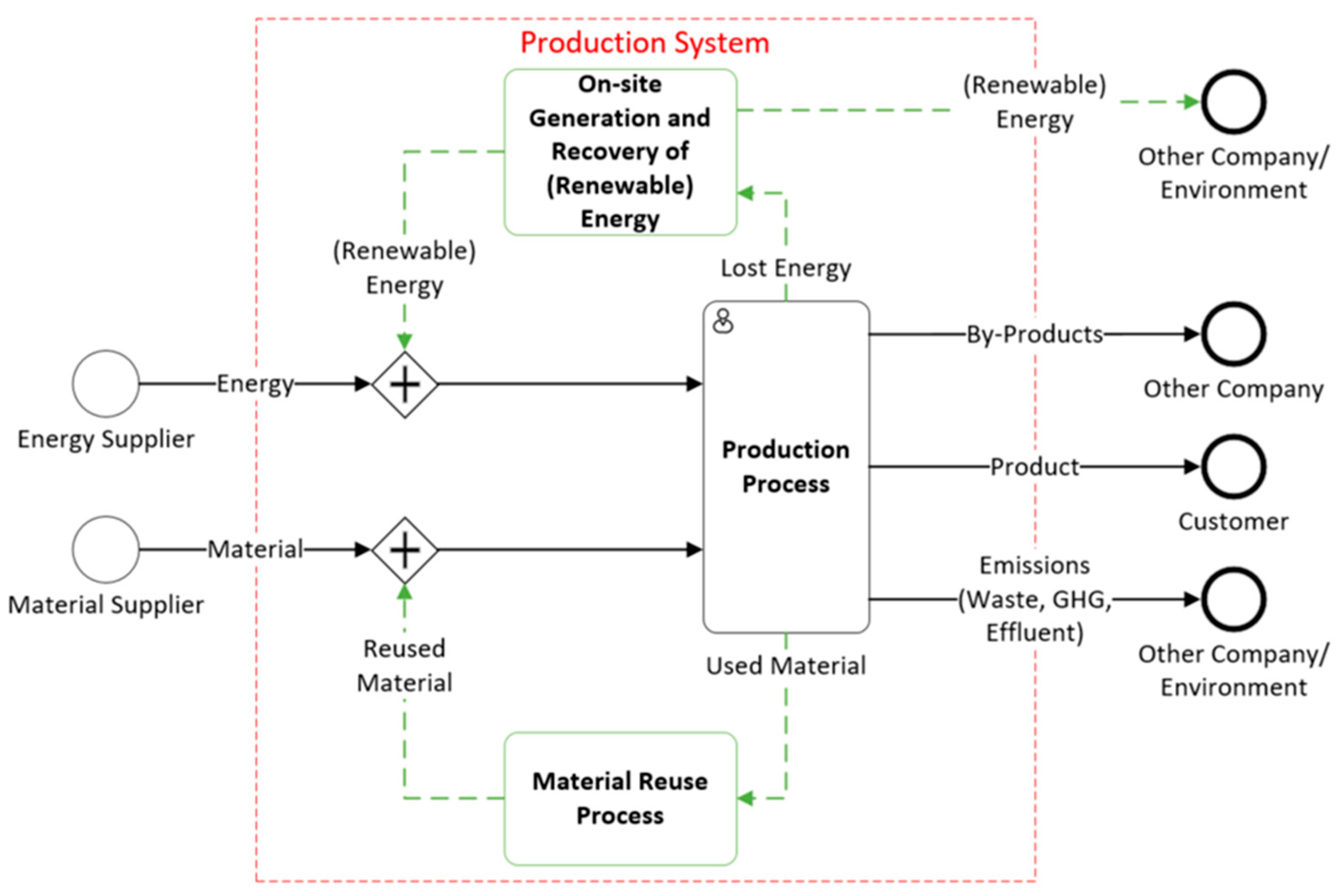



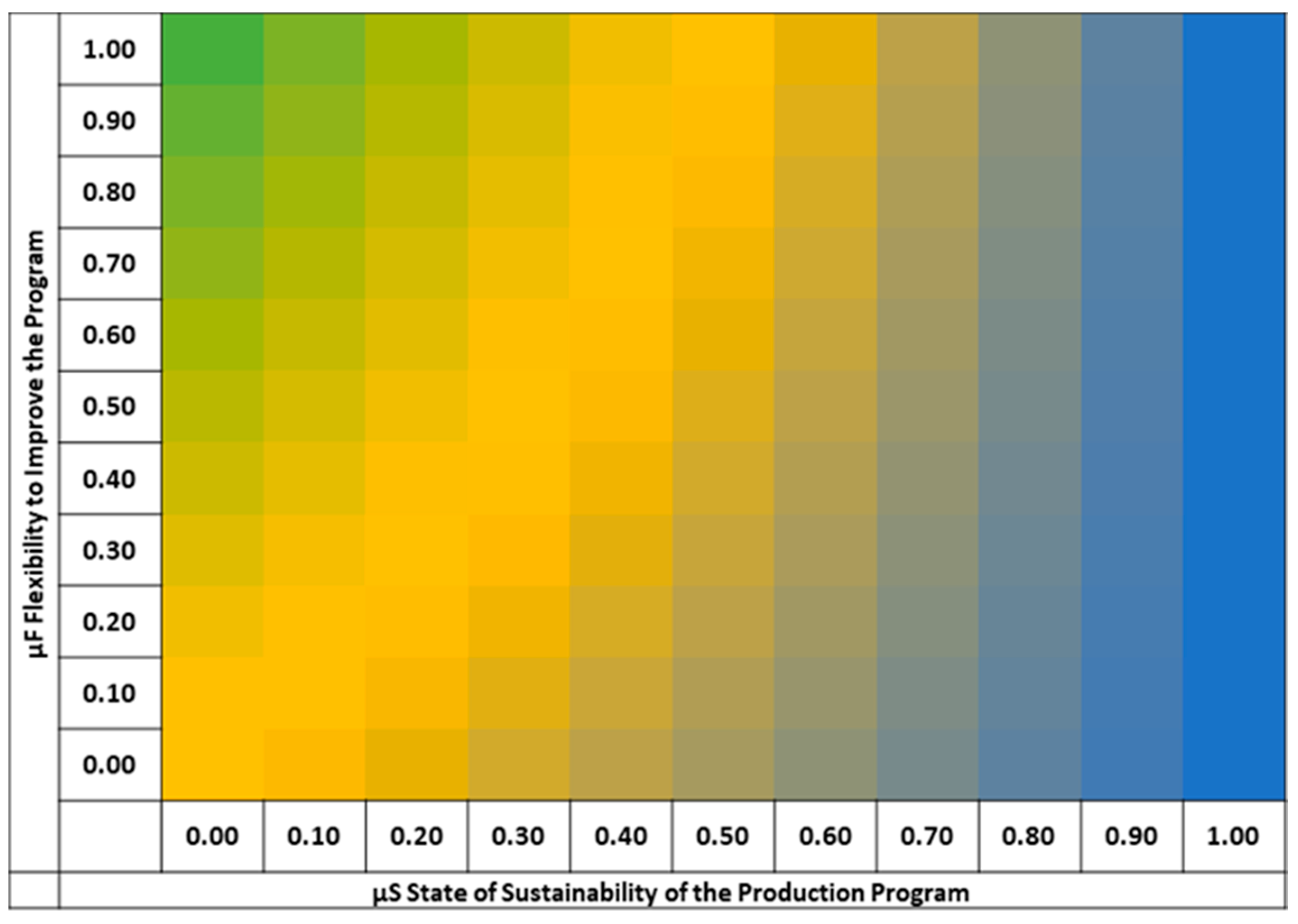



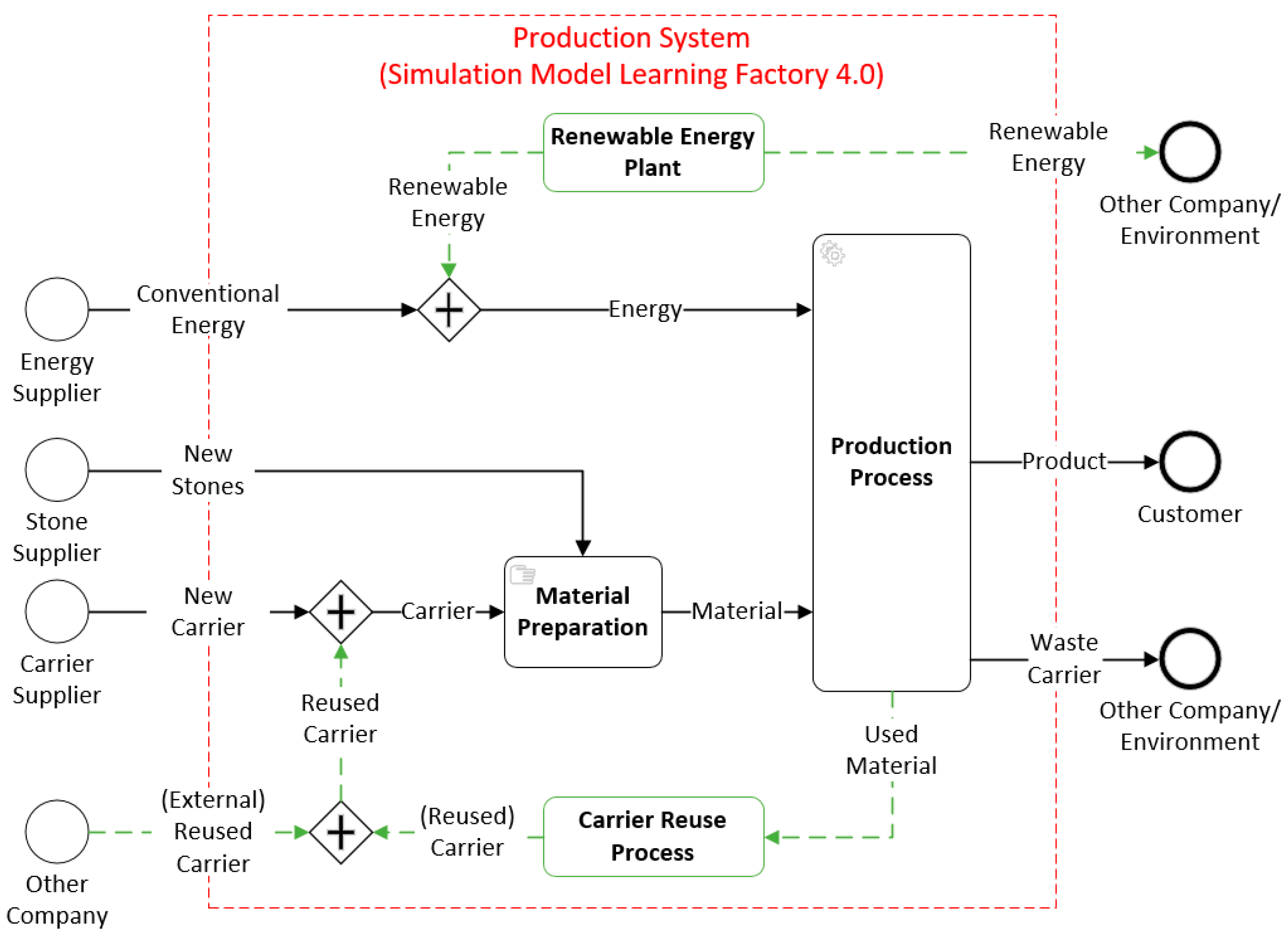
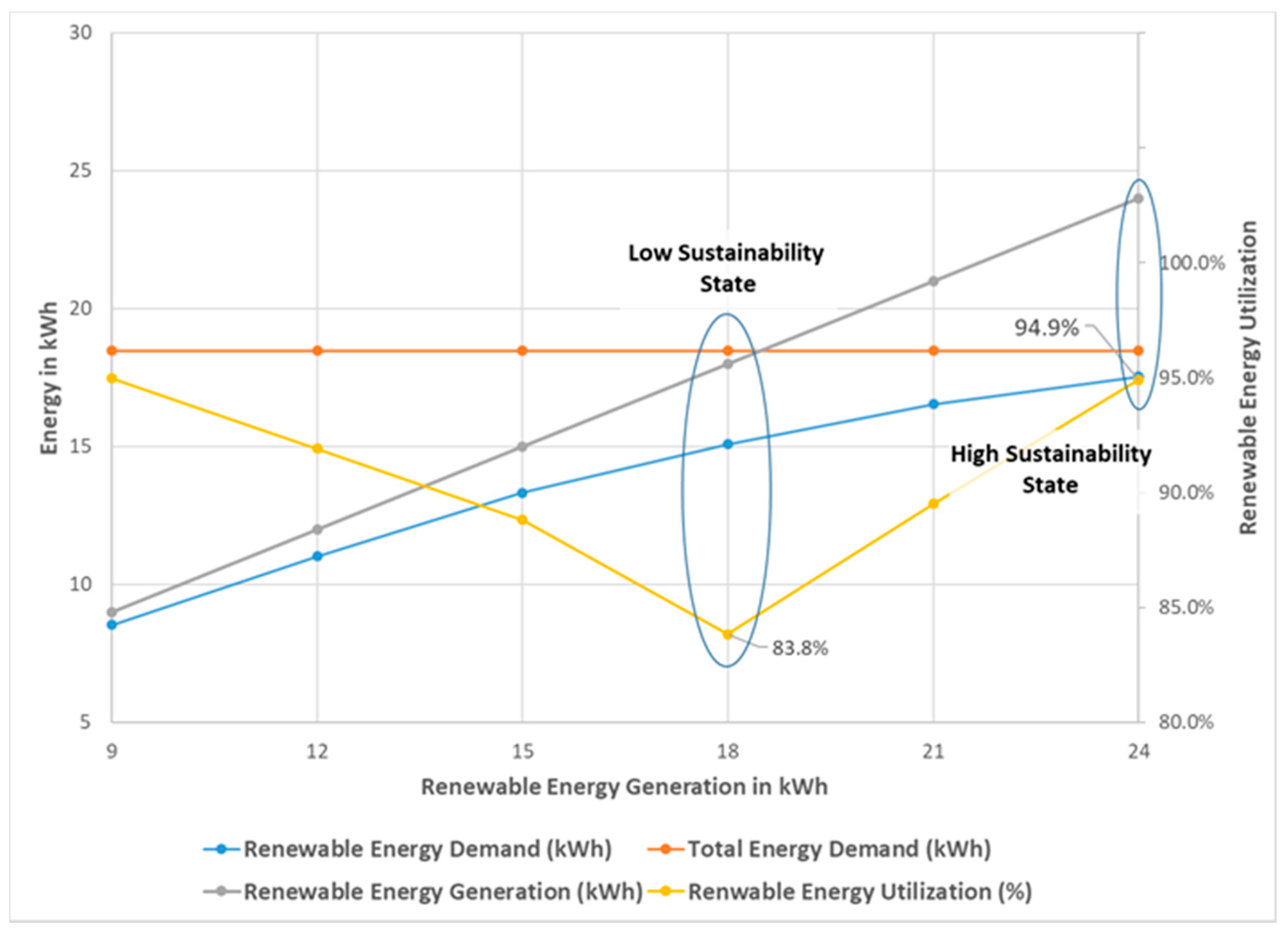
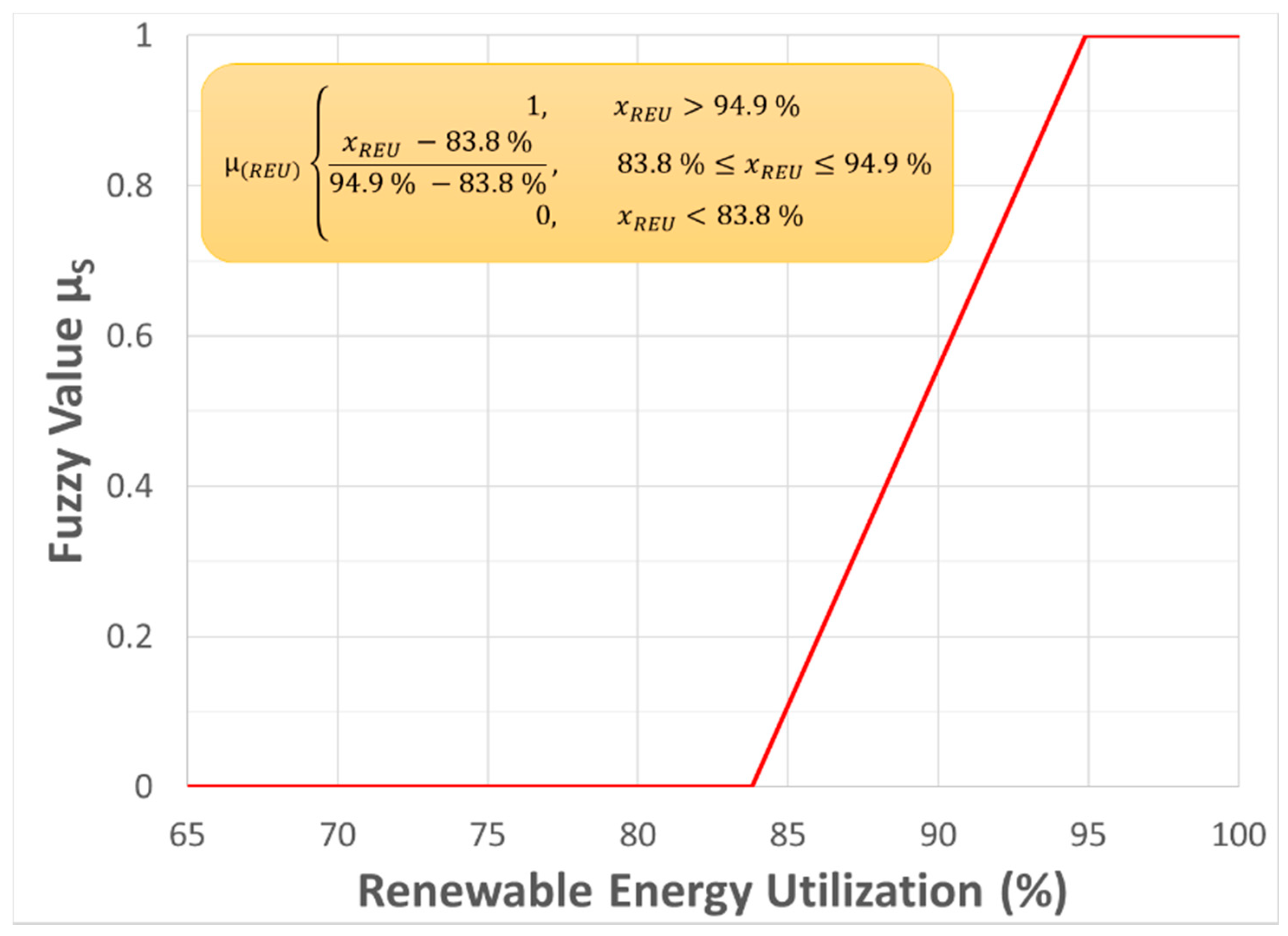
| Reference | Economic Sustainability | Environmental Sustainability | Social Sustainability |
|---|---|---|---|
| [8] | X | X | |
| [44] | X | X (Focus on Waste Reduction) | |
| [17] | X | X (Focus on Energy Efficiency) | |
| [11] | X | X | |
| [45] | X | X |
| Objective Function (Unit) | Variable |
|---|---|
| Processing of jobs within a certain makespan (h) | Makespan |
| Minimal total makespan to finish jobs (h) | Makespan |
| Minimal total tardiness time of jobs (h) | Tardiness time |
| Threshold for production volume (%) | Production volume |
| Minimal total inventory of products and semi-products (number of products/semi-products) | Inventory of products and semi-products |
| Objective Function (Unit) | Variable | |
|---|---|---|
| Economic Sustainability | Minimal energy production costs (Euro) | Energy cost |
| Minimal disassembly and shredding costs for recycling purposes (Euro) | Disassembly and shredding costs | |
| Minimal total production costs (Euro) | Production costs | |
| Minimal cost-weighted processing quality instability index (Euro) | Cost-weighted processing quality instability index | |
| Environmental Sustainability | Minimal total non-processing energy (kWh) | Non-processing energy |
| Threshold for the peak power (kW) | Peak power | |
| Minimal carbon dioxide (equivalents) emission (tons CO2) | Carbon dioxide (equivalents) emission | |
| Minimal total energy consumption (kWh) | Energy consumption | |
| Minimal number of setups of machines to avoid the emission of waste, effluent, and greenhouse gases (number of setups) | Number of setups | |
| Minimal use of freshwater through reusing (m3) | Use of freshwater | |
| Social Sustainability | Threshold for the minimum required human workforce for job tasks (h) | Human workforce |
| High learning rate of employees processing jobs (number of processed jobs) | Learning rate of employees | |
| Low forgetting rates of employees processing jobs (time period without processing the job) | Forgetting rates of employees | |
| Minimal risk of injuries and/or health impacts caused by physical stress on employees (risk of injuries, (human) energy expenditure performing jobs, Occupational Risk Assessment (OCRA) index) | Risk of injuries caused by ergonomic stress on employees; (human) energy expenditure performing jobs | |
| Maximal skill level of the employee | Skill level of the employee |
| Partial Flexibility | Variable |
|---|---|
| Machine flexibility describes the convertibility of machines to new products/materials. | Setup time |
| Material handling flexibility describes the (re-)routability and storage ability of materials. | Queue time in buffer zones |
| Volume flexibility describes the capacity adaptability of production resources. | Production capacity |
| Process flexibility describes the versatility of processes to adapt to new products. | Number of possible product variations which can be produced |
| Routing flexibility describes the redundancy of production resources. | Number of available resources |
| Production Goal | Potential to Improve the Sustainability of the Production Program |
|---|---|
Total Product Output Rate
| Use of Renewable Energy Potential:
|
| Variable | Membership Function Shape | Description Value X1 | Value X1 | Description Value X2 | Value X2 | Data Source and Method | |
|---|---|---|---|---|---|---|---|
| Product Output Goal | f |  | Total (or specific) required production output (of single products) in (products/hour). | 0–38 products/hour | Set by production planner based on forecast product data and customer requests. | ||
| Renewable Energy Utilization | µS,1 |  | Minimally acceptable renewable energy utilization for the production process in (%). | 83.8% of the available renewable energy. | Best-case of renewable energy utilization for the production process. | 94.9% of the available renewable energy. | Sensitivity analysis of the renewable energy demand in different production scenarios. |
| Average Queue Time | µF,1 |  | Queue time in (seconds/production hour), which offers no production flexibility. | 173.4 s/production hour | Queue time in (seconds/production hour), which offers high production flexibility. | 768.2 s/production hour | Sensitivity analysis of the queue time in different production scenarios for the production system. |
| Use of Recycled Carrier | µS,2 |  | Minimally acceptable reuse of internal and external carriers for the material preparation in (carriers). | 75% of the total used carriers for the production process. | Best-case of reuse of internal and external carriers for the material preparation in (carriers). | 90% of the total used carriers for the production process. | Set by production planner based on forecast product data and customer requests. |
| Total Product Output | µF,2 |  | Minimally product output, which offers no flexibility (products/hour). | Production output goal | Maximal possible production output (products/hour). | 120% of the production output goal | Set by production planner based on forecast product data and customer requests. |
| Accumulated Work Load Peak | µS,3 |  | Low work intensity | 250 kJ | Medium workload | 500 kJ | Empirical data from literature [54] |
| Average Queue Time Warehouse | µF,3 |  | Queue time in (seconds/ production hour), which offers no production flexibility. | 225.0 s/ production hour | Queue time in (seconds/production hour), which offers high production flexibility. | 772.0 s/ production hour | Sensitivity analysis of the queue time in different production scenarios for the warehouse process. |
| Variable | Value | Fuzzy Value | Aggregated Fuzzy Value (1. Step) | Aggregated Fuzzy Value (2. Step) | Defuzzification (Model Outcome) |
|---|---|---|---|---|---|
| f | 10 Products/hour | 1 | 1 | 0.501 | Potential to improve the production program´s sustainability is Medium. |
| µS,1 | 4.42 kWh (81.1%) | 0 | 0.501 | ||
| µF,1 | 173.4 s | 0.001 | |||
| µS,2 | 12 Carriers | 1 | 0 | ||
| µF,2 | 10 Products/hour | 0.444 | |||
| µS,3 | 124.16 kJ | 1 | 0 | ||
| µF,3 | 225 s | 0.003 |
| Variable | Value | Fuzzy Value | Aggregated Fuzzy Value (1. Step) | Aggregated Fuzzy Value (2. Step) | Defuzzification (Model Outcome) |
|---|---|---|---|---|---|
| f | 32 Products/hour | 1 | 1 | 0.833 | Potential to improve the production program´s sustainability is high. |
| µS,1 | 12.48 kWh (83.2%) | 0 | 0.808 | ||
| µF,1 | 539.2 | 0.617 | |||
| µS,2 | 21 | 0 | 0.833 | ||
| µF,2 | 32 | 0.667 | |||
| µS,3 | 376.7 kJ | 0.493 | 0.442 | ||
| µF,3 | 630 s | 0.743 |
Publisher’s Note: MDPI stays neutral with regard to jurisdictional claims in published maps and institutional affiliations. |
© 2021 by the authors. Licensee MDPI, Basel, Switzerland. This article is an open access article distributed under the terms and conditions of the Creative Commons Attribution (CC BY) license (http://creativecommons.org/licenses/by/4.0/).
Share and Cite
Zarte, M.; Pechmann, A.; Nunes, I.L. Fuzzy Inference Model for Decision Support in Sustainable Production Planning Processes—A Case Study. Sustainability 2021, 13, 1355. https://doi.org/10.3390/su13031355
Zarte M, Pechmann A, Nunes IL. Fuzzy Inference Model for Decision Support in Sustainable Production Planning Processes—A Case Study. Sustainability. 2021; 13(3):1355. https://doi.org/10.3390/su13031355
Chicago/Turabian StyleZarte, Maximilian, Agnes Pechmann, and Isabel L. Nunes. 2021. "Fuzzy Inference Model for Decision Support in Sustainable Production Planning Processes—A Case Study" Sustainability 13, no. 3: 1355. https://doi.org/10.3390/su13031355






